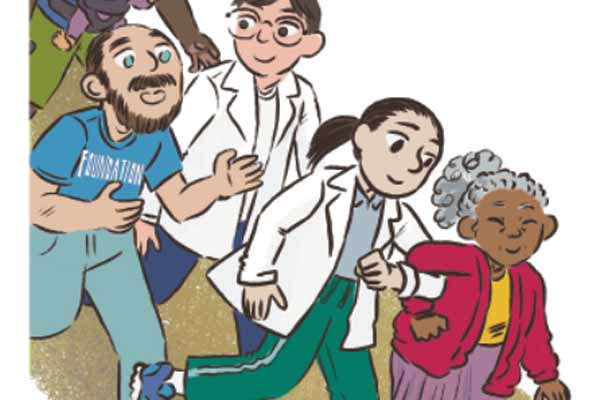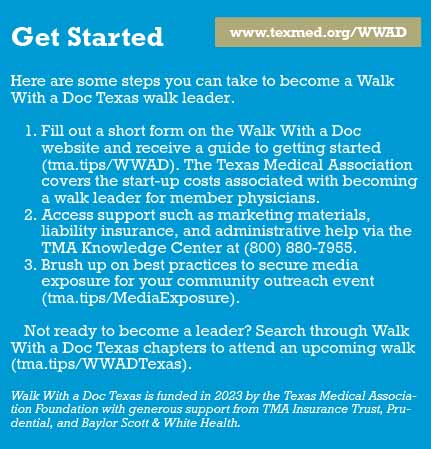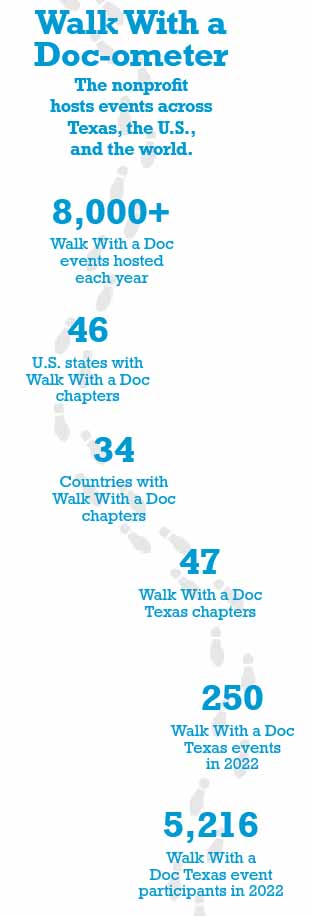
A patient with a host of physical health concerns as well as with anxiety frequently found herself in the office of Waco family physician Iliana Neumann, MD. But she’s since found relief on the walking path.
Dr. Neumann invited the patient to join her on monthly walks, which she leads through Walk With a Doc Texas, one of several Texas Medical Association community outreach programs.
Each month, the patient heads to the federally qualified health center where Dr. Neumann works. There, Dr. Neumann gives a brief presentation on a current health topic, like nutrition or colon cancer prevention, before the walk begins.
Since the patient began attending the hour-long events, her outlook and anxiety have improved, which Dr. Neumann attributes to her taking control of her health through regular movement.
The patient’s family members, including her husband, also have tagged along. After meeting Dr. Neumann in a neutral setting, outside of the exam room, and seeing her interact with his family members, the husband made an appointment to address his high blood pressure, something he had initially resisted.
Dr. Neumann says this trajectory is common among walkers – and the intended outcome of the parent Walk With a Doc program, now global in its reach.
“That sense of empowerment over their health is something that has bled over into a lot of other things,” she told Texas Medicine.
Walk With a Doc is a nonprofit – founded in 2005 by Ohio cardiologist David Sabgir, MD – that encourages physical activity in people of all ages and that aims to reverse the consequences of a sedentary lifestyle. And it has proven to come with so many other benefits to physicians themselves and to the patient-physician relationship.
Dr. Neumann started the Waco Walk With a Doc chapter in September 2021, during the throes of the COVID-19 pandemic, when many of her patients were isolated and struggling with depression and other mental health conditions. The early events allowed them to socialize safely and to bring their health concerns to her – ones they often forgot or were too embarrassed to bring up during appointments.
“We’re not only walking the walk, showing them that physical exercise is important, so much so that we’re doing it, but we’re also breaking down that barrier,” she said. “It just builds this trust and this relationship that I think is imperative if we’re going to make inroads in improving their health.”
More than a year into the program, Dr. Neumann touts its salubrious effects for her patients, who benefit from the opportunity to exercise, socialize, and have access to physician walk leaders. Worldwide, more than 71% of Walk With a Doc participants report getting more exercise since joining the program, and 93% feel more inspired to lead a healthier lifestyle, according to Walk With a Doc.
The physicians, residents, and medical students who lead the walks also benefit.
“The pandemic has been really hard on us doctors in terms of interactions with our patients with all the masking,” she said. “Being outside and building relationships really adds to our emotional well-being as well. So, it really helps with burnout.”

Conversation starters
Like Dr. Neumann, Jack Shope, a second-year student at the University of North Texas Health Science Center Texas College of Osteopathic Medicine (TCOM), says Walk With a Doc Texas helps tear down the kind of walls between patients and physicians that cause things like “white coat syndrome.”
Mr. Shope is immediate past president of the TMA Medical Student Section chapter at TCOM, which founded its own Walk With a Doc Texas chapter in June 2021. Since then, its monthly events have drawn as many as 30 participants.
Many of the walkers are elderly patients referred to the event by Fort Worth family physician Maria Crompton, DO, who runs a local primary care clinic and serves as the walk leader.
Mr. Shope says they relish the opportunity to be active, recover from medical procedures, regale the medical students with their patient stories, and offer advice about what makes for a good physician. He also appreciates the chance to get outside for an hour with his dog.
“Everyone always leaves happy,” he said. “Sometimes during the summer they’re sweaty, but we bring them water bottles. Sometimes in the winter they’re cold, but we bring them hot chocolate.”
The events also are a good jumping off point for more regular exercise, an initial appointment, or other community events.
For instance, the TMA medical student chapter at TCOM recently received a Local Impact Grant from the TMA Foundation, which funded a flu vaccine clinic at one of the chapter’s monthly walks. (See “Vaccines Continue to Defend What Matters,” page 24.) Mr. Shope says the crossover event helped ensure regular participants could access a flu vaccine while also drawing new attendees, many of whom were low-income, non-English speaking residents.
“It’s another bonus,” he said.
Building the patient-physician relationship
The TMA Foundation provided $57,707 to 57 Walk With a Doc Texas chapters in 2021, allowing TMA member physicians to become walk leaders without incurring any startup costs, which run around $2,300.
“The start-up cost is really the most prohibitive cost, but once that’s covered, you don’t need much more,” Mr. Shope said.
Carla Ortique, MD, an obstetrician-gynecologist in Houston who serves as vice president of the TMA Foundation Board of Trustees and co-chairs the foundation’s Grants Committee, says Walk With a Doc Texas is an obvious investment in community health.
“It’s a great opportunity for physicians to help their patients increase their knowledge of health care issues … and build trust with the community,” she said.
Such opportunities can be hard to come by. But Walk With a Doc Texas provides a rare forum outside of the exam room where doctors can “interact with patients in somewhat of an unconventional manner, less formal, out in the open,” she said.
The events also help patients find accountability partners and see their physicians as more human.
Dr. Ortique says this is especially important for older patients and patients from communities that historically have been marginalized, as they may be more likely to put physicians on a pedestal – a distance that can prove hard to bridge.
“The walks allow people to connect in a particularly powerful way,” she said. “When you’re walking, you’re all equal.”
